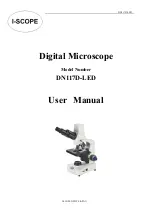
43
Set the light ring corresponding to the objective
engraving (e.g. PH
1
) on the condenser disc
(28.15) or use the light ring slide (7.7).
The double engraving
λ
and
λ
/4 on the UCL
condenser disc is without significance here (the
disc can be optionally equipped with light rings,
whole- and quarter-wave compensators for
polarization (9.6) or with the 2.5x lens (9.7)).
Individual labels can be stuck onto the UCA disc
(10 and 11).
Make sure to open the aperture diaphragm
(28.14) (= pos.
PH
).
Auxiliary telescope
Insert an auxiliary telescope* (30.1) into the
observation tube in place of an eyepiece.
Slightly loosen the clamp ring (30.3) and focus
the annular structures by adjusting the eyelens
(30.2). Retighten the clamp ring. This does not
apply for CL/PH and CLP/PH condensers (7.4).
Centering the light rings
Condensers UCL/UCLP and UCA/P (Figs. 7 and
10):
Insert both centering keys (7.5; 8.3) at the back
of the condenser (9.5; 9.3; 11.3a/b) and adjust
until the dark ring (PH = phase ring in objective)
coincides with the slightly narrower bright ring
(LR = light ring in condenser)
→
Fig. 31a – c.
Fig. 30
1
Auxiliary telescope,
2
Adjustable eyelens,
3
Clamp ring for
fixing the focus position,
4
Immersion oil,
5
Light trap for
fluorescence (interruption of transmitted light,
→
39.4)
Fig. 31
Centration process for phase contrast, observed with
an auxiliary telescope
a
Condenser in brightfield position (BF), PH = light ring in
objective,
b
Condenser in PH position, light ring LR not
centered,
c
Light ring and phase ring centered
4
1
2
3
5
a
b
c
PH
LR PH
LR+PH
Summary of Contents for DM L
Page 1: ...Leica DM L Instructions...
















































